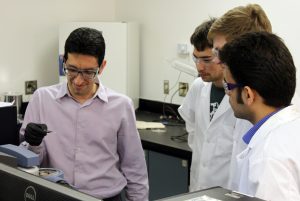Reza Foudazi, chemical engineering assistant professor at New Mexico State University, is developing innovative technologies to alleviate a critical worldwide problem: access to clean water.
Foudazi’s goal is to develop a water and wastewater purification method that uses less energy, costs less and uses a more ecofriendly alternative to removing bacteria than current technologies. Although his research focuses on water purification, the technology also has biomedical uses.
His research is funded by the NMSU Water Resources Research Institute and the U.S. Bureau of Reclamation.
“It’s a global problem,” he said. “Alleviating the adverse effects of contaminated drinking water is one of the biggest world challenges of our time. Access to clean water is not always available in remote and rural areas where power needed to run filtration systems is unavailable. It’s also a problem in urban areas, like Flint, Michigan.” In 2014, toxic lead from aging pipes leached into Flint’s water supply serving of 100,000.
Old methods of filtering water involved distillation by using heat to evaporate and then condense contaminated water, leaving behind impurities. The amount of energy needed for this process makes it prohibitively expensive.
Modern technologies involve filtration, utilizing materials such as sand, gravel and activated carbon. Filtration through permeable membranes is also commonly used. Following filtration, water is chlorinated to treat waterborne infectious bacteria, such as E.coli.
Foudazi and a group of graduate and undergraduate students are developing nanofiltration, ultrafiltration and microfiltration membranes. These membranes can filter out impurities, such as heavy metals, nitrates and other substances that taint water, along with treating proteins, bacteria and viruses that accumulate on the surface of membranes, thus eliminating the need for chlorine treatment.
“Chlorine is not a safe chemical and it has health effects and produces harmful disinfection byproducts. While the Environmental Protection Agency regulates the use of chlorine, it is a trade-off,” said Foudazi.
Nanofiltration and ultrafiltration membranes have very small pores – from a few nanometers to about 100 nanometers. Foudazi is experimenting with different pore sizes to ensure that the separation of contaminates is effective.
Additionally, the membranes are made from compounds that possess antibacterial qualities. Conventional antibacterial membranes are created through the application of antibacterial substances to the surface of the membranes through complex and expensive processes that require the use of harmful solvents.
Perhaps the biggest challenge in membrane technology is increasing the flow rate while decreasing the energy requirement used to push the fluid through the membrane. Highly permeable membranes can filter the water by gravity rather than being pushed by some means requiring electricity.
“We are using materials that are commercially available, such as surfactants, compounds that are found in everyday products like detergents and personal hygiene products.” Surfactants lower the surface tension between the liquid and solids. Foudazi uses a templating approach in which a high density of pores with the same size can be produced within a thin polymeric layer.
Foudazi estimates that this process may render the water filtration process roughly 50 percent less expensive than conventional methods. His process can be scaled-up for industrial purposes as well as adapted in small portable units for production in rural areas and small communities.
This technology also has usefulness in the biomedical field and could be used to create artificial kidneys, said Foudazi.
“The membrane works just like our kidneys – they filter the blood to remove waste and control the balance of the blood.”
With potential for commercialization, Foudazi is working with NMSU’s Arrowhead Center on patenting the process. He already has two patents related to technologies used in the capture of carbon dioxide.
“Eye on Research” is provided by New Mexico State University. This week’s feature was written by Linda Fresques of the College of Engineering.

